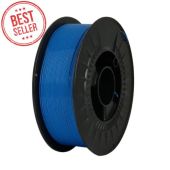PETG Printing Temperature: How to Get the Best Results
Nozzle (Hot End) Temperature
The nozzle temperature should typically fall between 220°C and 260°C. Most users find the sweet spot between 230°C and 250°C.
Some standardize on 240°C, while others adjust depending on the brand or filament color, as color additives affect the melting characteristics.
- Higher temperatures (245°C to 260°C) usually improve layer bonding and strength.
- Lower temperatures (220°C to 230°C) reduce stringing but may weaken adhesion.
For consistent results, it's smart to print a temperature tower with each new spool.
Bed Temperature
Bed adhesion is another critical factor. The general recommendation is 70°C to 90°C.
- For standard prints, 80°C is often sufficient.
- On glass beds, increase to 85–90°C to avoid warping.
- For textured PEI sheets, 70–80°C is typically enough.
Too high a bed temperature may cause soft first layers or excessive adhesion. Too low, and the print may detach mid-process.
Cooling & Fan Settings
Unlike PLA, PETG is less tolerant of heavy cooling. Use moderate fan speeds:
- 30% to 50% is the typical range.
- First few layers: use no fan or minimal cooling to improve bed adhesion.
- After that, moderate cooling helps prevent stringing and oozing, especially on detailed parts.
Overcooling can cause weak inter-layer adhesion and brittle parts.
Print Speed & Retraction
Printing too fast with PETG can result in weak prints. The ideal speed range is:
- 30–60 mm/s
To reduce oozing and strings:
- Use faster travel moves.
- Increase retraction distance slightly compared to PLA.
- Adjust retraction speed moderately.
Dialing in these settings can significantly reduce post-processing time.
Environmental Considerations
PETG is sensitive to external conditions:
- In cold environments, increase bed temperature slightly.
- In warm or humid rooms, you may need to start with lower bed temps.
- PETG absorbs moisture from the air. Always store spools sealed with desiccant.
- Run a temperature tower for every new filament roll to avoid guessing.
Community Insights & Practical Tips
Experienced users often combine manufacturer guidelines with hands-on testing:
- Start at 230°C for the first layer, then increase to 235°C or more for the rest of the print.
- Temperature towers help identify the best nozzle temperature for your specific PETG batch.
- Many stick to the settings printed on the spool box, adjusting only after trial runs.
Choosing the Right PETG Filament
Looking for a filament that balances strength, precision, and ease of use? PETG printing temperature recommendations are just the starting point.
3DTrcek’s PETG filament is designed for engineers, product designers, architects, and makers who need reliability in demanding applications. Whether you're producing technical prototypes, custom enclosures, or mechanical parts, this filament offers:
- Strong inter-layer adhesion
- Resistance to chemicals and wear
- Low warping and minimal shrinkage
It’s a top choice for functional prints that need to perform.
Final Thoughts
Mastering PETG starts with understanding the right printing temperature. Keep nozzle settings between 230°C and 250°C, bed temperatures around 80°C, and don’t neglect fan control or storage.
Test each spool, keep your setup consistent, and you’ll get reliable results print after print.
For reliable PETG filament options and detailed specs, explore what 3D Trček offers. Their materials are backed by user data and real-world performance, helping you avoid guesswork and wasted prints.
; ?>) Shop PETG Filament
Shop PETG Filament


Please complete your information below to login.
Sign In
Create New Account